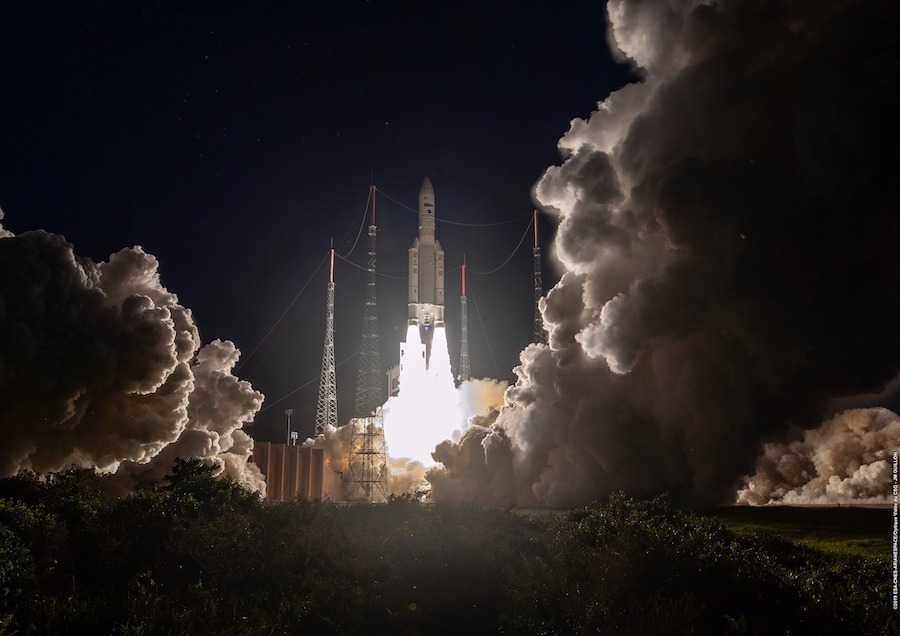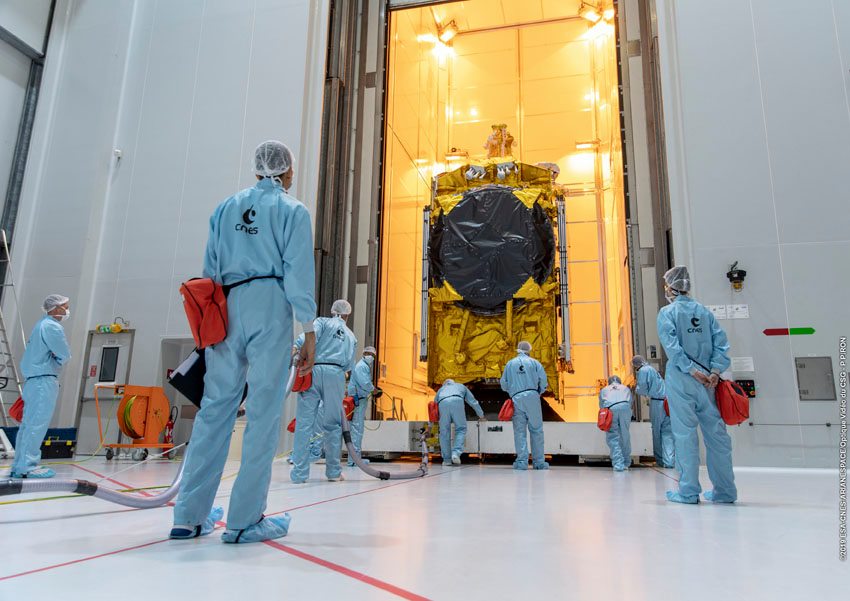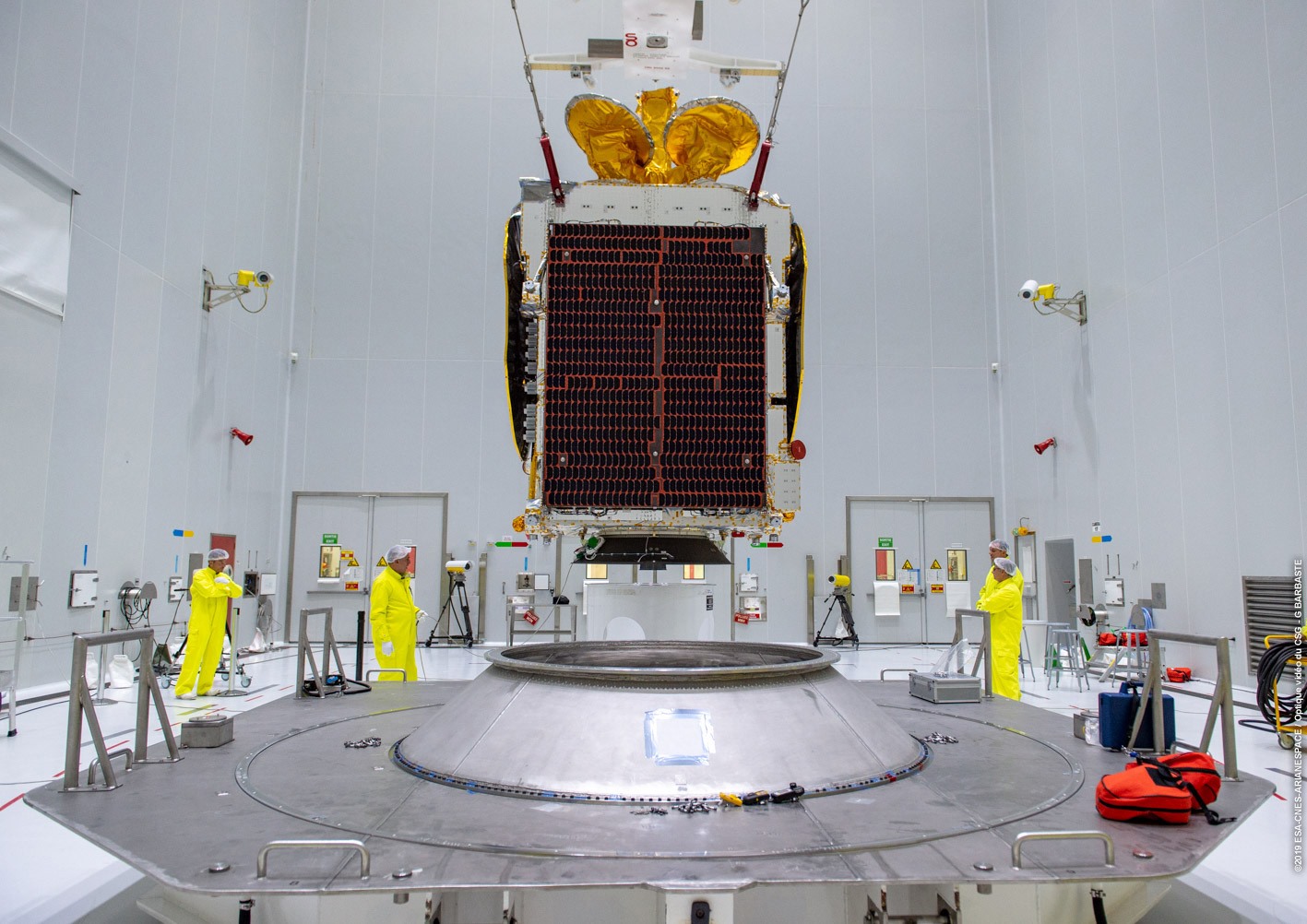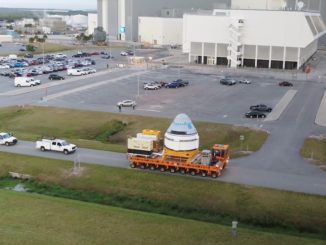
Egypt’s first military communications satellite and a powerhouse spacecraft to beam Internet signals to airline passengers and maritime vessels across Europe and the Middle East rocketed into orbit Tuesday on the 250th flight of an Ariane launcher.
Running four days late after delays attributed to a ground power supply anomaly and unfavorable weather, the Ariane 5 rocket lit its core stage Vulcain 2 engine at 4:23 p.m. EST (6:23 p.m. French Guiana time; 2123 GMT) Tuesday, ran through a computer-controlled health check, and then ignited two powerful solid-fueled boosters to fire off its launch pad at the Guiana Space Center.
The 167-foot-tall (51-meter) rocket took off from the ELA 3 launch zone and steered toward the east, climbing though a partly cloudy sky just after sunset at the spaceport carved from the edge of the Amazon jungle on the northeastern coast of South America.
The launch Tuesday was delayed 14 minutes to wait for acceptable high-altitude winds.
The Ariane 5 jettisoned its twin solid rocket boosters around two-and-a-half minutes into the mission, then released its Swiss-made payload fairing to reveal the TIBA 1 and Inmarsat GX5 satellites after ascending through the thick, lower layers of the atmosphere.
The TIBA 1 satellite was the larger of the two payloads launched Tuesday. It launched in the upper berth of the Ariane 5’s bulbous payload shroud. Underneath a composite adapter sat Inmarsat GX5, which separated from the launcher after TIBA 1 in the Tuesday’s flight sequence.
The Ariane 5’s Vulcain 2 main engine, consuming a mix of super-cold liquid hydrogen and liquid oxygen, shut down around nine minutes after liftoff. Seconds later, the core stage separated to fall back to Earth and the Ariane 5’s upper stage HM7B engine, also fed by hydrogen fuel, ignited to inject the TIBA 1 and Inmarsat GX5 satellites into a geostationary transfer orbit with a targeted low point of 155 miles (250 kilometers), a high point of 22,199 miles (35,726 kilometers), and an inclination of 5 degrees.
TIBA 1 deployed from the Ariane 5 upper stage around 27 minutes into the mission, followed by the ejection of a Sylda dual-payload adapter structure to uncover the Inmarsat GX5 spacecraft, which separated 34 minutes after liftoff.
“Arianespace is delighted to announce that TIBA 1 and Inmarsat GX5 have been separated as planned in their targeted geostationary transfer orbit,” said Stephane Israel, CEO of Arianespace, the company in charge of Ariane 5 launch operations. “Success tastes even better when a little patience is needed. That was the case tonight.”
“Tonight is a very special launch for many reasons,” Israel continued. “We are now celebrating, with this launch, the 250th launch from the Ariane family. The journey started at Christmas 1979, on the 24th of December, with Ariane 1, and we are now almost 40 years later. What a journey we have done together. We are all really proud that this launch, which is really special for all the Ariane family, has been delivered for loyal partners and customers.”
The TIBA 1 and Inmarsat GX5 are destined for circular geostationary orbits more than 22,000 miles (nearly 36,000 kilometers) over the equator, where their velocities will match the rate of Earth’s rotation, causing them to appear in a fixed position in the sky.
Egypt ordered the TIBA 1 communications satellite in 2016 as part of a purchase of French military equipment reportedly worth more than $1 billion. French officials released no further updates on the Egyptian satellite until October, when satellite-builder Airbus Defense and Space announced its name and assignment to the next Ariane 5 launch.

Airbus Defense and Space and Thales Alenia Space, rivals in the satellite manufacturing industry, collaborated on the TIBA 1 project. Airbus said it supplied the Eurostar E3000 satellite platform, assembled the spacecraft, and tested the satellite.
Airbus described Thales Alenia Space as the “leading partner” on the mission. Thales Alenia Space designed and built the spacecraft’s payload, Airbus said, featuring a dual-mission Ka-band package for secure and broadband communications.
Jean-Loïc Galle, CEO of Thales Alenia Space, said the TIBA 1 satellite “will give Egypt a dual-use civilian and government telecommunications system that is extremely efficient and secure in Ka-band, based on the latest digital payload and antenna technologies.”
TIBA 1 is designed for mission in geostationary orbit lasting more than 15 years, and weighs around 5.6 metric tons — or 12,345 pounds — fully fueled for launch, Airbus said.
The satellite will unfurl its solar panels and maneuver into a circular geostationary orbit over the equator at 35.5 degrees east longitude, where it enter service in the next few months.
Inmarsat’s GX5 satellite is the fifth spacecraft to join the London-based company’s Global Xpress network. The 8,833-pound (4,007-kilogram) GX5 satellite was built by Thales Alenia Space and can route more data than the previous four Boeing-built Global Xpress satellites, which launched from 2013 through 2017 on Proton and Falcon 9 rockets to create a network with global reach.
“The terrific initial success of our new GX services are driving us to a second phase of network evolution as we now look to augment our capabilities to meet huge growth in demand from our customers, as well as keep GX well ahead of our current and future competition,” said Rupert Pearce, Inmarsat’s chief executive.
The Global Xpress network works in Ka-band, beaming broadband Internet signals to airline passengers, maritime vessels, and other far-flung users, including U.S. military forces.
Inmarsat says terminals for its GX maritime service, known as Fleet Xpress, have been installed on around 7,000 ships. The company also provides in-flight Internet service for 27 airlines and more than 600 business jets.
“The launch of our fifth satellite in the GX fleet represents a step-change advance in the capabilities of our GX services to meet the growing demand of aviation passenger connectivity and commercial maritime services across Europe and the Middle East, delivering a bandwidth increase that is greater than the combined capacity of our entire existing GX fleet,” Pearce said.
The GX5 satellite will provide more communications capacity than the previous four Global Xpress satellites combined, according to Inmarsat. The satellite will be parked in geostationary orbit at 11 degrees east longitude, supplementing Inmarsat’s service over Europe and the Middle East.

“Some of our highest (maritime) demand is in the North Sea, shipping routes coming through there, the Mediterranean, the Persian Gulf,” said Mark Dickinson, Inmarsat’s deputy chief technology officer and vice president of the company’s space segment. “We serve airlines like Qatar. Their routes coming out of the Middle East up into Europe are very important. We also have quite a few airlines within Europe as well, like Lufthansa. This will be delivering key capacity for those users.”
Inmarsat plans to launch five more Ka-band payloads to expand the company’s Global Xpress network in the next few years.
Two of the Ka-band payloads, known as GX6A and GX6B, will fly on the company’s Inmarsat 6 F1 and F2 satellites scheduled for launch in late 2020 and 2021. The Inmarsat 6 satellites, built by Airbus, will also host communication payloads operating in L-band, which Inmarsat uses to provide persistent emergency and safety-of-life voice and data relay services for maritime vessels.
The Ka-band network can support higher-bandwidth services, but Ka-band is more susceptible to interruption from rainfall.
“Inmarsat 6 is a big investment in the future of L-band,” Dickinson said in an interview with Spaceflight Now. “L-band is still very important to us. L-band has some very specific use cases which aren’t suitable for Ka-band. The fact that we have two global independent networks in different bands allows us to do interesting things. You can have terminals that work in both bands. For example, in maritime, if there was ever a rain fade event in Ka-band, you could fall back to L-band.”
Inmarsat has ordered three additional Global Xpress geostationary satellites from Airbus, which will build the spacecraft on the company’s new OneSat platform. Airbus says the OneSat satellite bus is based on a “standard, modular, and design-to-manufacture approach” that can be built and delivered in as little as 18 months, half the time needed to manufacture some large geostationary satellites.
Scheduled for launch in 2023, the GX7, GX8 and GX9 satellites will be able to adjust their coverage, capacity and frequency in real-time in space.
“You only put capacity where you need it at that instant … So you don’t have capacity where there are no users to serve,” Dickinson said. “You use the satellite resources — power and bandwidth — exactly where you need it second-to-second. That revolutionizes the efficiency of the spacecraft and it future-proofs our GX network.
“These satellites can be stacked on the same launch vehicle, so you can get two of them on a Falcon 9-class rocket,” Dickinson said. “That allows you to be able to get the cost of the capacity in orbit dramatically down.”
Inmarsat is also planning to put Ka-band payloads on two Space Norway communications satellites scheduled for launch in late 2022 on a SpaceX Falcon 9 rocket from Vandenberg Air Force Base, California. The two Space Norway spacecraft will fly in elliptical orbits that enable communications coverage over the North Pole, extending the Global Xpress network’s reach to serve ships and airplanes traversing the Arctic.
Email the author.
Follow Stephen Clark on Twitter: @StephenClark1.



